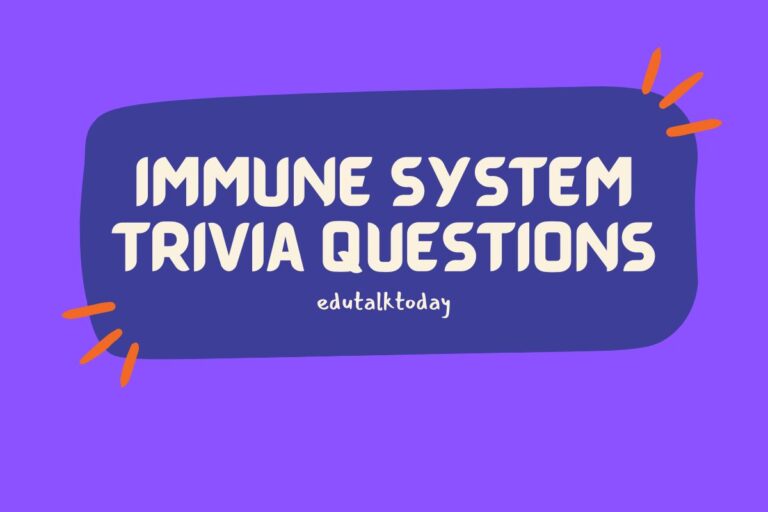21 Circulatory System Trivia Questions

The circulatory system is an intricate network responsible for transporting nutrients, oxygen, and hormones to cells throughout the body while removing waste products. It’s a vital part of human anatomy, and understanding its functions can be both fascinating and essential for maintaining good health.
Whether you’re a medical student, a biology enthusiast, or simply curious about how your body works, here are some engaging trivia questions to challenge your knowledge of the circulatory system.
Let’s begin.
Circulatory System Trivia Questions
- What is the primary function of the red blood cells, and what molecule do they use to fulfill this function?
- Describe the process and significance of the pulmonary circulation within the circulatory system.
- How does the structure of capillaries facilitate their function in the circulatory system?
- What are the differences between systemic circulation and pulmonary circulation in terms of their pathways and purposes?
- Explain the role of the SA node (sinoatrial node) in the heart. How does it influence the heart’s function?
- Detail the mechanism through which blood pressure is regulated in the human body.
- What is the function of the valves found in the heart and veins, and how do they contribute to circulatory system efficiency?
- Describe the process of gas exchange in the capillaries of the alveoli and the systemic capillaries. How does this process differ between these two locations?
- What are baroreceptors, and how do they function in the regulation of blood pressure?
- Explain the significance of the double circulatory system found in mammals, including humans. How does it differ from the circulatory systems of other organisms?
- What is atherosclerosis and how does it affect the circulatory system’s function?
- Explain the significance of the blood-brain barrier within the context of the circulatory system.
- Detail the pathway blood takes through the heart, starting from the vena cava and ending with the aorta.
- How do arterioles and venules differ in structure and function within the circulatory system?
- What role does the lymphatic system play in the circulatory system, and how are they interconnected?
- Describe the composition of plasma in human blood and its functions within the circulatory system.
- Explain the physiological mechanisms behind the formation of varicose veins.
- How does the fetal circulatory system differ from that of an adult, specifically regarding the foramen ovale and ductus arteriosus?
- What is the role of platelets in blood clotting, and how does this process prevent excessive blood loss?
- Discuss the impact of high altitude on the circulatory system and how the body adapts to these conditions.
- Describe the process and function of angiogenesis within the circulatory system.
Answers
- The primary function of red blood cells is to transport oxygen to the body’s tissues and remove carbon dioxide from them. They use the molecule hemoglobin to bind and carry oxygen.
- Pulmonary circulation is the process of moving deoxygenated blood from the right ventricle of the heart to the lungs for oxygenation and then back to the left atrium of the heart. It is significant because it ensures that blood is oxygenated before it is pumped into the systemic circulation.
- Capillaries have thin walls (only one cell layer thick) that allow for easy exchange of gases, nutrients, and waste products between the blood and tissues, facilitating the body’s metabolic activities.
- Systemic circulation moves oxygenated blood from the left ventricle through the body and returns deoxygenated blood to the right atrium. Pulmonary circulation moves deoxygenated blood from the right ventricle to the lungs for oxygenation and then back to the left atrium. The main difference is in their pathways and purposes: systemic for nourishing the body and pulmonary for oxygenating the blood.
- The SA node acts as the heart’s natural pacemaker, initiating the electrical impulses that set the rhythm for the heart’s contractions. It regulates the heart rate based on the body’s needs.
- Blood pressure is regulated through the actions of the heart, blood vessels, kidneys, and various hormones that adjust heart rate, blood vessel diameter, and blood volume. These mechanisms ensure blood pressure remains within a healthy range.
- Valves in the heart (atrioventricular and semilunar valves) and veins prevent the backflow of blood, ensuring it moves in the correct direction through the heart and circulatory system, contributing to efficiency.
- Gas exchange in the capillaries involves oxygen moving from the blood to the body’s tissues and carbon dioxide moving from the tissues to the blood in systemic capillaries, while in the alveoli capillaries, oxygen from inhaled air moves into the blood and carbon dioxide is expelled. The main difference is the direction of gas exchange relative to the body’s needs.
- Baroreceptors are sensors located in the walls of blood vessels that detect changes in blood pressure. They send signals to the brain to adjust heart rate, blood vessel diameter, and blood volume to maintain stable blood pressure.
- The double circulatory system, with separate pulmonary and systemic circuits, allows for more efficient oxygenation of blood and distribution throughout the body compared to single circulatory systems. This system supports higher metabolic demands in mammals, including humans.
- Atherosclerosis is the build-up of fats, cholesterol, and other substances in and on the artery walls (plaque), which can restrict blood flow. It affects the circulatory system by increasing the risk of blood clots, leading to heart attacks, strokes, and other cardiovascular diseases.
- The blood-brain barrier is a selective barrier that prevents most substances in the blood from entering the brain, protecting it from pathogens and toxins while allowing essential nutrients to pass through.
- Blood enters the heart through the vena cava, moves into the right atrium, passes through the tricuspid valve to the right ventricle, is pumped through the pulmonary valve into the pulmonary artery and lungs, returns via the pulmonary veins to the left atrium, passes through the mitral valve into the left ventricle, and is finally pumped through the aortic valve into the aorta.
- Arterioles are small arteries that regulate blood flow into capillary beds via vasoconstriction and vasodilation; venules are small veins that collect blood from capillary beds and return it to larger veins. Arterioles have thicker muscular walls for regulation, while venules have thinner walls and less muscle tissue.
- The lymphatic system returns excess tissue fluid to the bloodstream and helps in the absorption of fatty acids and immune system functioning. It is interconnected with the circulatory system through the transfer of lymph fluid into the blood vessels.
- Plasma, the liquid component of blood, is composed of water, salts, enzymes, antibodies, and other proteins. It functions in transporting nutrients, hormones, and proteins to the parts of the body that need them.
- Varicose veins are caused by weakened or damaged valves that fail to prevent the backflow of blood, leading to pooled blood and enlarged veins, often in the legs.
- The fetal circulatory system includes the foramen ovale and ductus arteriosus, which allow blood to bypass the lungs and liver, as these organs are not fully functional before birth. These structures close after birth, redirecting the blood flow.
- Platelets, or thrombocytes, are cell fragments that clump together and interact with coagulation factors to form blood clots, preventing excessive blood loss from damaged vessels.
- At high altitude, reduced oxygen levels cause the body to adapt by increasing red blood cell production, enhancing the ability of blood to carry oxygen, and sometimes increasing heart rate and breathing rate.
- Angiogenesis is the process of new blood vessel formation from existing vessels. It is crucial for growth, healing, and the formation of granulation tissue during wound healing.






